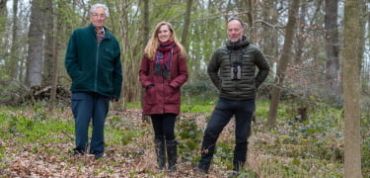75 years of the influential Great Tit study at Wytham Woods
Wednesday 27th Apr 2022, 6.59am
Wytham Woods’ Great Tit study celebrates 75 years and reveals how spring has advanced a calendar month in that time.
On 27 April 1947, the first Great Tit egg of the year was counted in the University of Oxford’s ‘living laboratory’ at Wytham Woods. It was to be the start of a deep and on-going relationship between the bird population and generations of researchers.
Seventy-five years later, in 2022, the year’s first Great Tit egg was counted on 28 March; almost exactly a month earlier than its predecessor from 75 years ago.
The Wytham Great Tit study is the longest continuous study of an individually-marked animal population in the world. It plays a key role in scientists’ understanding of how populations change in response to the environment – particularly how they are coping with changing climates.
Sir David Attenborough said: ‘I am delighted to hear of the 75th anniversary of the long-term Great Tit study in Wytham Woods. Having visited several times, I know how fundamental this study, and others like it, have been for our understanding of the impacts of climate change on the natural world.
‘Long-term studies like this require long-term commitment, and I wish the study – and its practitioners – a long and productive future.’
Like many aspects of their biology, the timing of the laying of Great Tit eggs is influenced by large and small-scale factors, such as climate, social interactions and the health and behaviour of nearby trees, which researchers are beginning to understand in terms of potential vulnerabilities and resilience to changing climates.
 One of 1209 nest boxes at Wytham
One of 1209 nest boxes at WythamCredit: Ella Cole
Great Tits make excellent study species for ecological research as they readily take to nest boxes, breed at high densities, do not travel far from where they are born, and cope well with being monitored by scientists. Researchers can individually tag large numbers of nestlings (with unique leg rings) and follow them throughout their lifetimes.
Currently researchers use breeding data from 1209 fixed-location nest boxes in the Site of Special Scientific Interest to the west of Oxford, together with information on many other aspects of the ecology of Wytham Woods, collected by other scientists based at the University of Oxford. As the study has developed it has increasingly made use of new technology, including electronic tags, remote-sensing, and genome analysis to understand evolution.
 Chris Perrins, Ella Cole and Ben Sheldon
Chris Perrins, Ella Cole and Ben SheldonChris Perrins, Ella Cole and Ben Sheldon of the Wytham project team
Credit: John Cairns
Professor Ben Sheldon, who leads the Wytham Great Tit study, said: ‘A study of this duration is built on the work of hundreds of people, and it’s been a great privilege to build on their dedication year in, year out, to continue the study.
‘That continuity has enabled us to use many decades of data to understand how changes occur over time. One of the most striking changes is that the average Great Tit breeds three weeks earlier now than it did at the start of the study. This shift is a clear signal of the effects of climate change on one of our most familiar woodland and garden birds, and it is studies of this kind that allow us to work out what the consequences of such changes have been, and what they may be in the future.’
More than 70 PhD theses have been completed on the project and over 350 scientific papers published.

